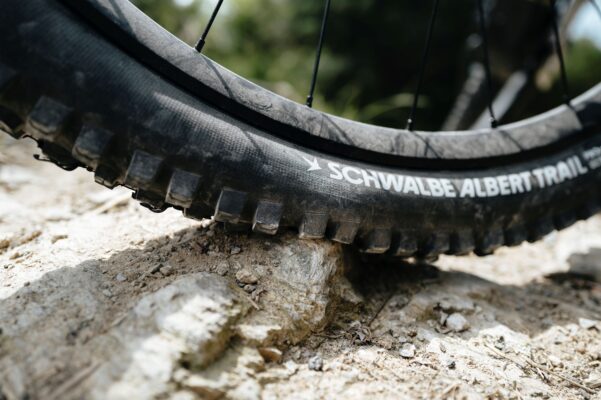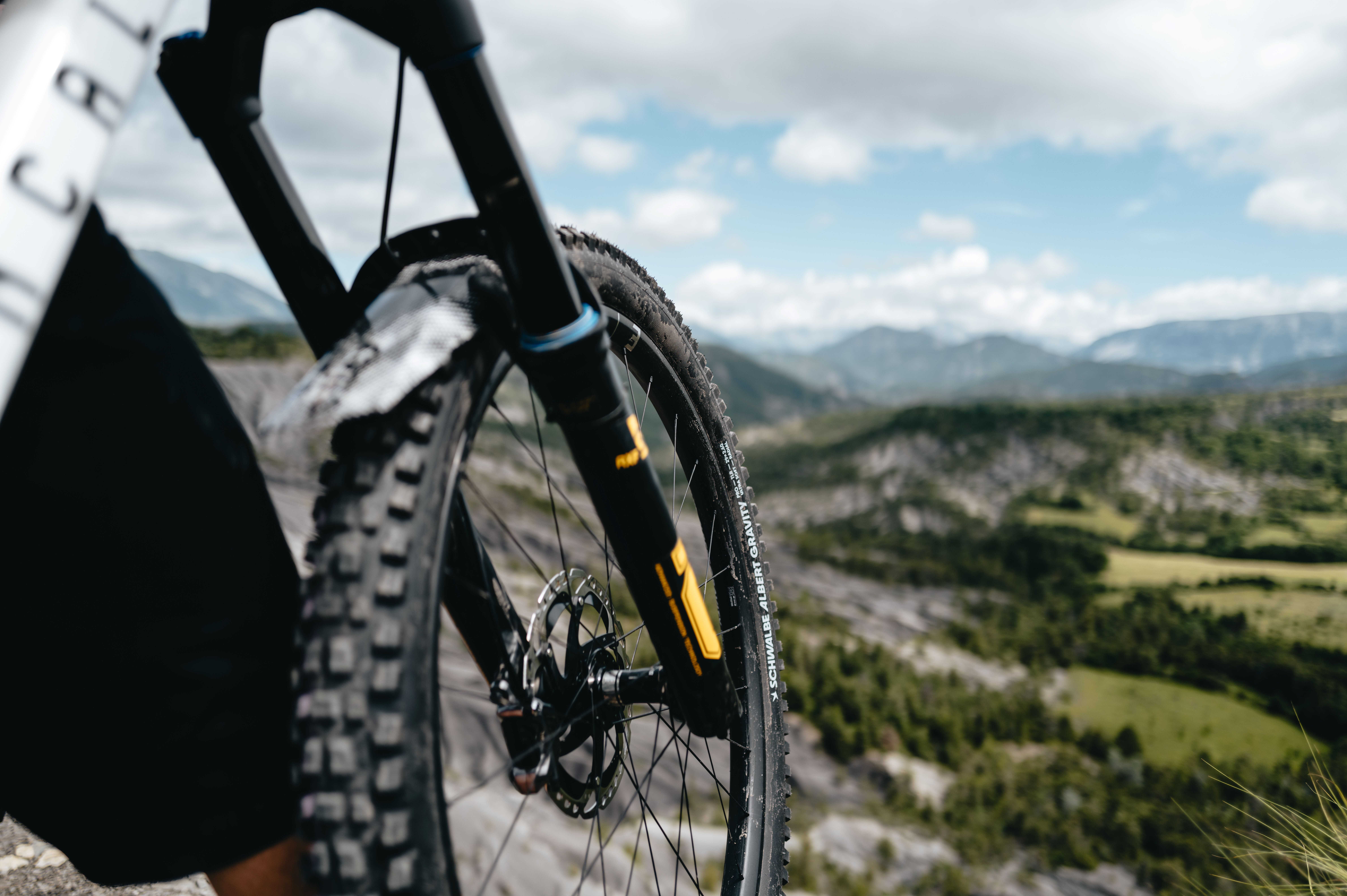More grip, comfort and compliance, all with much higher pressures for puncture protection and support... look out Maxxis
Schwalbe has two new tyres out, called the Albert and Shredda, they both use radial technology never before seen on mountain bike tyres, and represent a “technological milestone,” according to the German brand.
Designed for gravity and e-bike use respectively, the Albert and Shredda uses radically different carcasses that claim to deform better than standard tyres and increase grip and control. Schwalbe recons each tyre’s footprint is around 30% bigger thanks to the radial design. That could make them some of the best mountain bike tyres, period.
Schwalbe radial tyres need to know
- Two new tyres with radial technology, the Albert for gravity riding and Shredda for e-bikes
- Radial technology sees the carcass threads aligned across the tyre from bead to bead, with claimed better deformation
- Schwalbe says its radial tyres offer more comfort, damping and grip than regualar ply tyres
- Magic Mary radial tyre in production also, to join the new tech line-up
- Albert comes in 27.5in and 29er
- Shredda is front and rear specific, front is 29er only, rear comes 27.5in or 29er

The new radial threads run across the tyre rather than diagonally along it, leading to less overlap of a standard ply construction
What are radial tyres?
Radial tyres aren’t new, they’ve been around for 70 years on cars and more recently moto has adopted the technology. The Albert and Shredda are the first time we’ve seen the technology on mountain bikes though, and could represent a new age of tyres. Schwalbe’s got its work cut out though, Maxxis just launched the High Roller III, for mixed conditions, while the new Michelin Wild Enduro excellend in our testing.
First up then, radial tyres refer to the carcass. That’s the meat of the tyre, which supports you and the bike rather than the rubber surface that connects to the trail. The carcass is made from threads of material that have traditionally run diagonally across the tyre, at 50° to the way it rolls. Radial tyres however have threads that run 90°, or almost straight across from bead to bead.

Schwalbe says the radial construction leads to a bigger footprint for the same pressure, which is good news for those who like their tyres to grip
Is radial better?
Schwalbe definitely thinks radial is better than the traditional ply design, it says there’s less overlap between the threads and that leads to less tension in the tyre. In turn that means the tyre can deform more easily around the trail, giving a bigger footprint for the same pressure. More surface area means better grip, everything else being equal.
“Radial tires offer approx. 30% more contact area than conventional tires at the same air pressure,” Schwalbe says. “Even if the air pressure is increased by 50%, the contact area is still 15% larger and the tire retains its flexible properties.”
We’re not 100% convinced yet though, because while shortening the length of the casing fibers and reducing the overlap does make a more forgiving tyre, there are some downsides. And you’ve probably already guessed them already, we’re talking higher rolling resistance and less support. According to one industry expert I spoke to, air pressure needs to be increased to make up for that loss in cornering and vertical stability. At an extreme angle a radial tyre could start to float under hard cornering and pinch flat easier too.

The Albert is a mixed conditions gravity tyre, with something of an Assegai look to it
Albert and Shredda details
Schwalbe Albert
- 29 or 27.5in, 2.5in
- Soft or Ultra Soft compound
The Albert is a downhill tyre, Schwalbe has taken the chunky shoulder lugs from the Tacky Chan, but made the overall profile rounder with more closely packed lugs, Schwalbe says.
“We have much more rubber on the ground and several lugs that are constantly in contact with the ground,” Schwalbe says. “In combination with the larger contact area of the radial tires, this gives you exceptional control when riding, whether braking or accelerating.”

The Shredda is not shy, with huge side lugs ideal for soft terrain
Schwalbe Shredda
- 29×2.5in front only: 29in or 27.5in rear option
- Ultra Soft compound only
The Shredda is front and rear specific, and designed for e-bike use. It’s lugs are monstrous, bigger even than the Dirty Dan mud spike, with 10mm tread depth on the shoulder and 8mm in the middle. Schwalbe says these are the biggest knobs it’s ever made.
It looks plenty like a motocross tyre, with uniformly spaced lugs running down the middle, and the shoulders too. It’s a tyre for muddy or soft conditions then, “the tread depth with the open tread design ensures good interlocking, especially on soft ground,” according to Schwalbe.
Why is it e-bike specific then? For starters that’s a lot of tyre to lug around. Schwalbe also says the big spikes make it “ideal for transferring momentum on soft ground despite the higher weight of an e-MTB.” It’s reportedly good for steering uphill too, because of those big lugs.
The rear tyre features smaller lugs, and reinforced bridges between the central knobs to provide support.
 Green tyres
Green tyres
These new radial tires are made from recycled carbon black, replacing the “100% fossil-based carbon black rubber of old”. Presumably this means there is still some virgin material in there, but at a much lower level, and the claim is an 80% CO₂ saving over the old tyres. Bravo Schwalbe.
However, there is a caveat that the ADDIX Ultra Soft rubber compound isn’t included in this new process, which means the Shredda (ultra soft only) isn’t as green.
What about the existing Schwalbe lineup?
There’s a radial version of the Magica Mary in the works, available in both the soft and soft compounds.
The radial revolution?
Radial tyres have long been touted on cars as more comfortable than cross-ply tyres, which represent all mountain bike tyres up till this date. That’s because the rubber surface of the tyre is less impacted by movement from the sidewalls, damping the impact of the road. This would definitely give some great advantages to mountain bike trails, where damping is really important to maintain traction.
Schwalbe also says that because radial tyres offer more contact with the ground you can choose your own tyre pressures, increasing it as you wish “with virtually no negative impact on suspension behavior and comfort,” Schwalbe says. As I’ve touched on though, it might be necessary to increase air pressure, rather than optional.
Amaury Pierron won in Les Gets with a lead of 6.498 seconds, and in Val di Sol by 4.893 seconds
It’s working for Amaury Pierron, afterall. Schwalbe is keen to point out the French DH star won Les Gets with a lead of 6.498 seconds, and in Val di Sole by 4.893 seconds. How much of this is down to his talents, and how much is down to tyres is anyone’s guess though.
What’s clear though is that if the radial tyre concept really does work – we’ll let you know when we’ve tested a set – every other tyre brand in the world will need to play catch up. Maxxis, Continental, Michelin, Specialized and the rest already do play around with thread angulation to balance stability and grip. And if the trend continues for greater compliance over stability, the Albert and Shredda could have the edge.
We’ve since had a set to test, and you can read Mick Kirkman’s full review of the Schwalbe Albert Radial Gravity tyres here.





